Editor’s note: This guide focuses on the Nautic-Ski produced by the French watch brand Lip from 1967 to 1976, and does not encompass the modern reissues of the Nautic-Ski by the current owners of the Lip brand.
Today, the Nautic-Ski is widely known and adored among pockets of watch collectors in France and Europe but otherwise remains an obscure and under-appreciated footnote in watchmaking history, with vintage examples trading at values well below models of the same era with lesser historical importance and technical specification. This article tells the story of the Nautic-Ski through its most noteworthy executions, and attempts to provide readers with a primer on this endearing watch and brand.
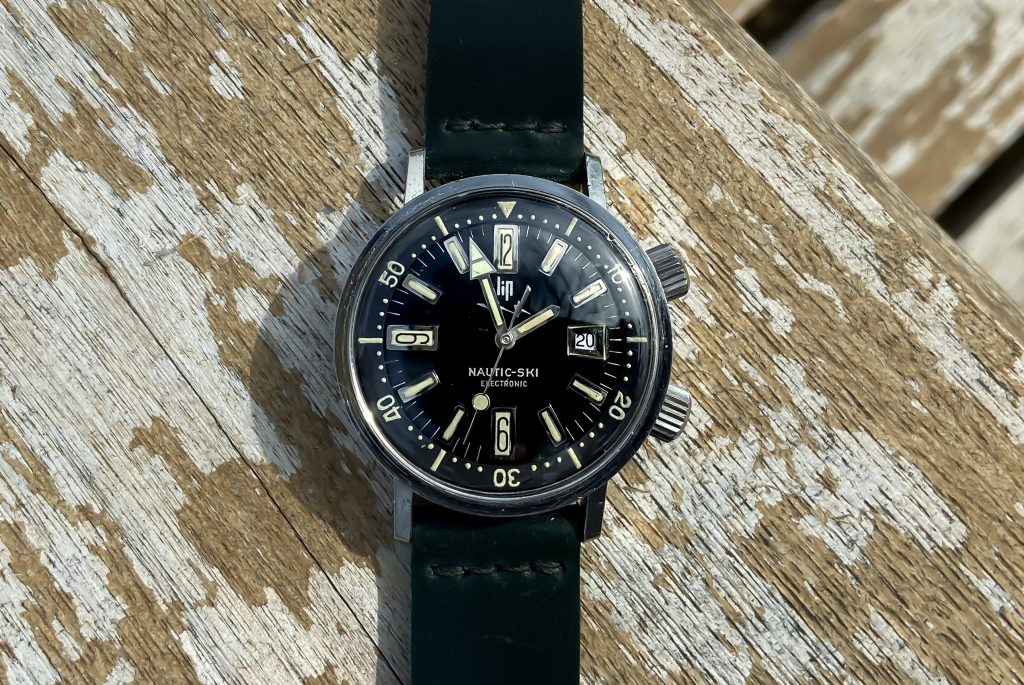
In 1967, the French watch brand Lip commemorated its 100-year anniversary with a timepiece that embodied the company’s avant-garde spirit and cocksure innovativeness better than any other: The Nautic-Ski.
With a proprietary Super Compressor case made by the famed Ervin Piquerez S.A. (EPSA) company, a hi-tech in-house electro-mechanical movement (the caliber R184), and a dial-and-handset design that sought to blend the futuristic and the traditional in one eccentric package, the Nautic-Ski was decidedly Lip.

To put this centenary into perspective, consider that no French watchmaking concern had ever been as influential and successful as Lip. Lip was France’s largest watchmaker, one of the only French watch brands with a presence outside the country, and a continuously run family business since 1867. This anniversary was a very big deal. The safe and easy decision would have been to rework a classic Lip reference for modern tastes and sensibilities—a refresh of a best-selling chronograph, perhaps, or an update of the tonneau-shaped “T-18” Charles De Galle gave to Winston Churchill as a gift after World War II. But true to its ethos, Lip opted for the unconventional, without apology.
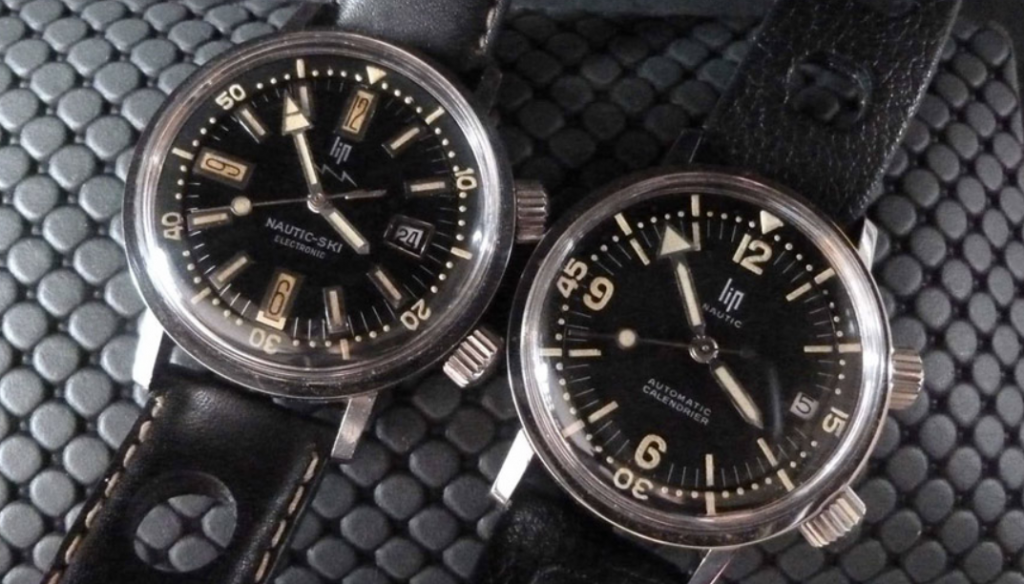
The designers took the “Nautic”—a mechanical dive watch that had been on the market for only several years—and reimagined it for Lip’s R184 movement. The word “Ski” was added to capitalize on the soaring popularity of alpine skiing in France and the excitement surrounding the 1968 Winter Olympic Games, slated to be held in Grenoble, France. For Fred Lip, the maverick director of Lip brand, the addition of “Ski” to the dial was driven as much by marketing opportunity as his family’s deep love of skiing: His daughter, Muriel, had competed in the women’s slalom at the 1956 Winter Olympics in Cortina d’Ampezzo, Italy. The Nautic-Ski was born.
The Nautic-Ski was the first diver to be fitted with an electronic movement and the first 200-meter-water-resistant watch to be equipped with an internal rotating bezel.
The result was a watch that managed to feel futuristic and laissez-faire at the same time. It was as much a head-turner as a head-scratcher. It was also a technical ground-breaker. The Nautic-Ski was the first diver to be fitted with an electronic movement and the first 200-meter-water-resistant watch to be equipped with an internal rotating bezel.
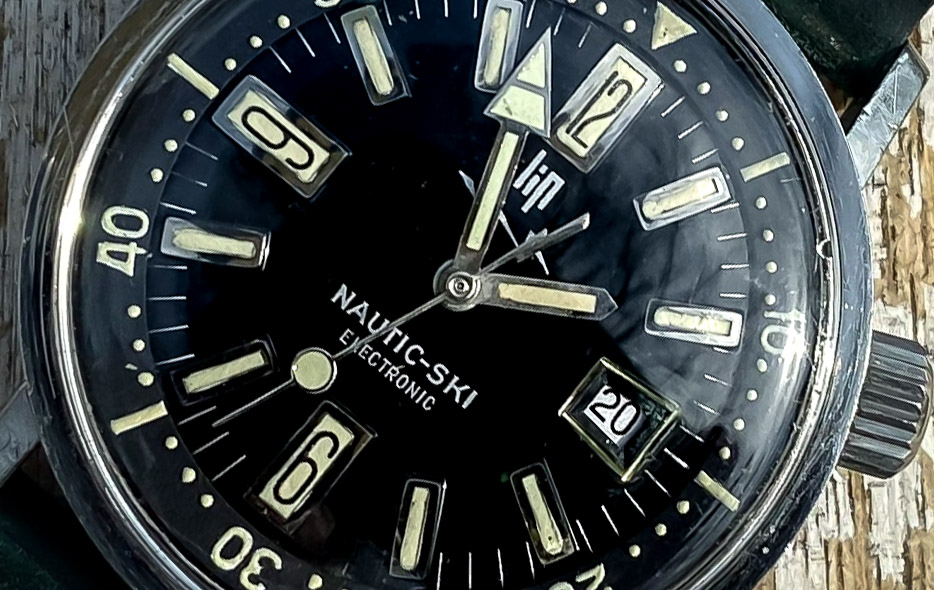
“When properly serviced, these Lip movements are very reliable,” says Jarett Harkness, founder of Unwind in Time, which specializes in the sales and service of electric watches. “They used a tiny diode to reduce any sparking on the contacts. This prevented any carbon buildup, which would eventually prevent conduction of the current, causing the watch to stop. I have never seen a carbon buildup issue on a Lip electronic watch.”
To Harkness, an electronic movement is actually ideal for a dive watch. As he explains to Beyond the Dial, “any time the crown has to be turned to wind a watch, or set it after it has stopped, wear can occur there, which could eventually result in water ingress. With an electronic watch, none of that is needed, so the most one might have to set is for day of month adjustments.”
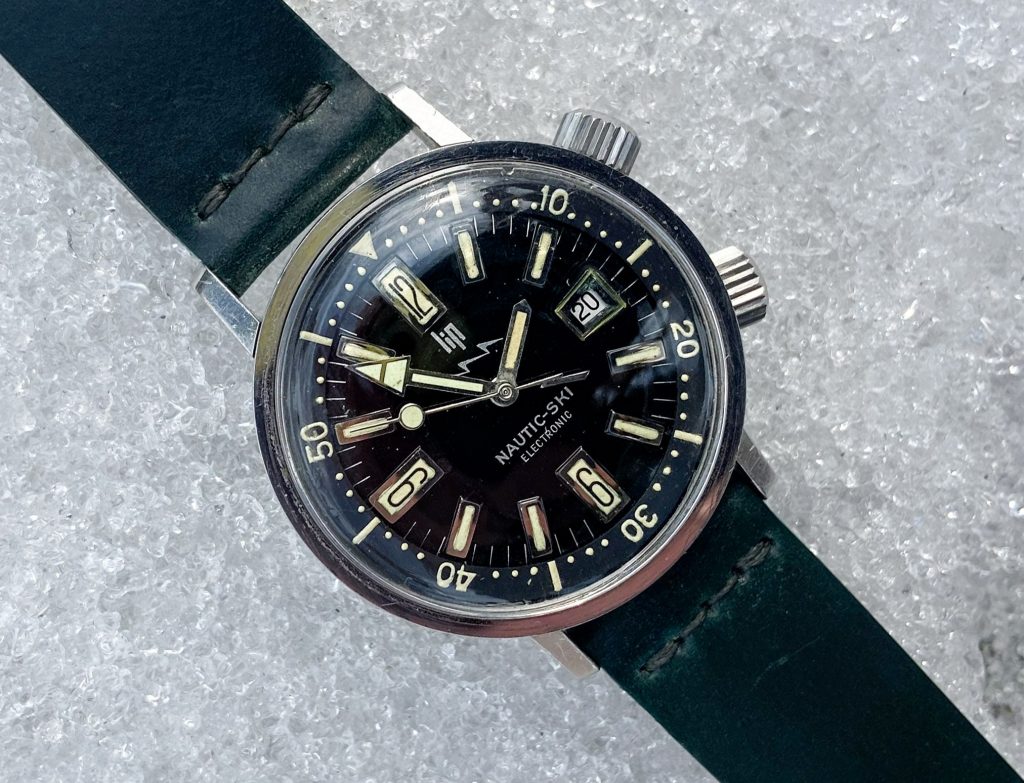
For Lip, the technological marvel of the R-184 resulted in brisk sales. As the official timepiece of the French Olympic team and later a favorite of Jacques-Yves Cousteau’s dive team for its build quality and precise timekeeping, the Nautic-Ski became a best-seller for the brand and a French design icon. Offered at 375 Francs ($415 USD) beginning in the spring of 1967, the original Nautic-Ski featured a glossy black dial with gold luminous hands and markers. At the urging of fashion-designer Pierre Cardin, Lip released the watch in a range of colorways and dial designs, which were immensely popular with younger consumers. As the decade came to a close, Lip experimented with larger case sizes and new dials and even made versions for other watchmakers. The result is a nice variety of Nautic-Ski models for the vintage collector to seek.
The MK1 Nautic-Ski
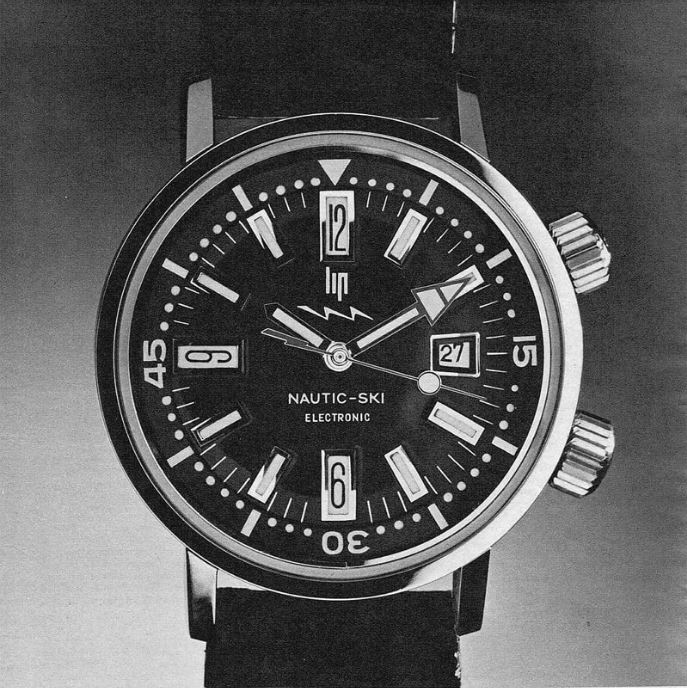
Reference: 42554
Movement: Electronic caliber R184
Dimensions: The iconic 1967 inaugural model came in an exclusive 36 mm EPSA case. On the wrist, the watch wears much larger, owing to the pair of chunky cross-hatched crowns (clocking in at 6.2 mm in diameter and 3.8 mm tall), a high-domed acrylic crystal, and an overall thickness of 14 mm. The width between the lugs its short, simple, and almost-inconspicuous at 18 mm.
Dial: The glossy black dial features applied tritium-filled markers throughout; the markers at 12, 6, and 9 are ever so slightly larger and include printed numerals similar to that of the Zodiac Sea Wolf. The Lip logo and lightning bolt are printed below 12. NAUTIC-SKI and ELECTRONIC are printed above 6. The date window is trapezoidal in shape with gold bordering; the date disc has black text on white background. The black inner bezel bears applied tritium lume throughout—for an inverted triangle at 12 o’clock, dots and hash marks, and 10, 20, 30, 40, and 50 marks (Note: these inner bezels often faded to a charcoal gray, and the lume on some examples appears to have been hand-applied).
Hands: The hour hand is plongeur style, an hour hand most commonly associated with the Omega Seamaster Ploprof. (Plongeur is the French word for diver.) The all-important minute hand is an arrow-style hand, with its triangle tip divided into two sections (most likely to keep the applied lume stable). The tail end of the lollypop second hand is a lightning bolt. Part of the joy of this watch comes from watching that lightning bolt stutter-step around the dial.
Caseback: The MK1 casebacks were marked Electronic, Patent-Pending, Super Waterproof, and came with an engraved crest. Six-digital serials should be present. Some models have “JO” engraved on the back, indicating the watch was produced in 1968, the year of the winter Olympics.
The MK2 Nautic-Skis
Here we will consider the second generation of the Nauti-Ski. The images below represent the key references: 42983, 42982, 42827.

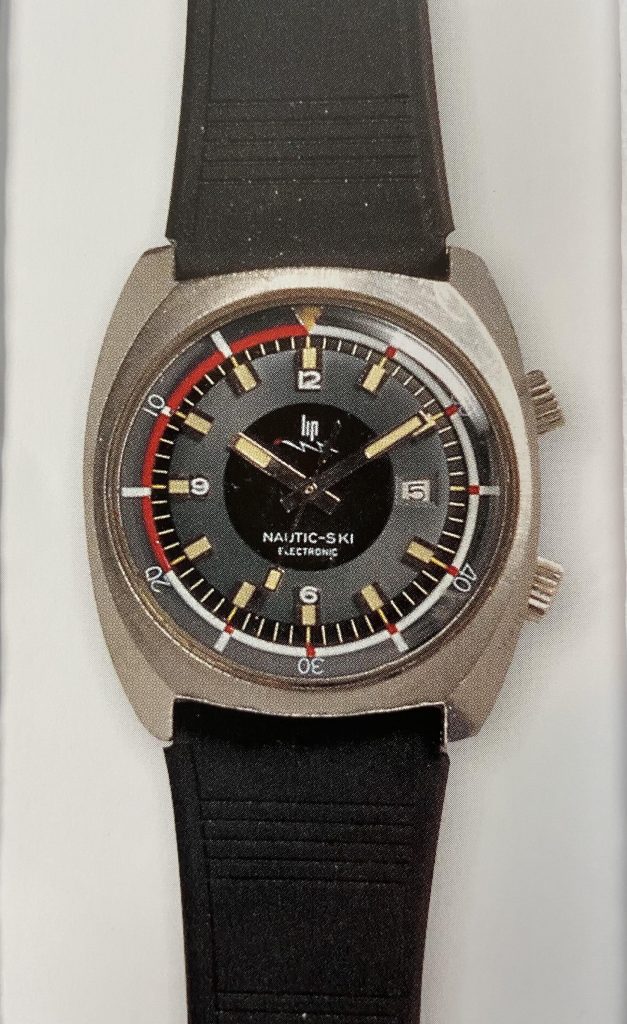

References: (From top to bottom) 42983, 42982, 42827
Movement: Electronic caliber R184
Dimensions: Following the release of the MK1 Nautic-Ski in the late 1960s, Lip issued a second version in the later part of the 1960s and early 1970s with a 40 mm EPSA case. The crowns are no longer cross-hatched; the thickness is roughly the same as the MK1.
Dial: For the MK2, Lip experimented with myriad dial designs. One of the most popular is a blue or gray tuxedo-esque dial with applied markers (printed numerals inside the markers at 12, 6, 9). The date window and date disk is the same as the MK1s. The internal rotating bezel is now different; this unique MK2 bezel counts the minutes down rather than up. Rather than setting the bezel zero marker to the minute hand before a dive and counting minutes underwater, the diver decides how many minutes to dive and set the bezel number (15 minutes) to match the minute hand. When the minute hand reaches zero on the bezel, it’s time to surface.

Hands: The hour and minutes hands are now tritium-filled batons. The second hand is a pallet with the lightning bolt at the tail.
Caseback: Screw-down; marked Stainless Steel Water Resistant 20 ATU; a six-digital serial should be present. On many models, this text has worn away.
The Super Nautic-Ski

Reference: 42634
Movement: Electronic caliber R184
Dimensions: Similar to Enicar’s Sherpa Super Jet, Lip offered a supersized version of the Nautic-Ski beginning in the early the 1970s. The case on this watch is large at 42mm in width without crown and 43mm lug to lug. Like the MK2s, its all-steel case has brushed and polished surfaces; however, the crowns are cross-hatched again. But this time the large crowns are recessed into the case.
Dial and Hands: The same as the MK2; the most commonly seen configuration is the blue version as shown above.
Caseback: Screw-down, marked Water Resistant, Shock Resistant; a six-digital serial should be present. On many models, this text has worn away.
The ‘French Flag’ Nautic-Ski

Around the time Lip introduced larger-cased Nautic-Skis, the brand offered this 36-mm model with the different handset-and-dial configuration. This variant featuring the colors of the French flag is the most commonly seen.
The Grey Nautic-Ski
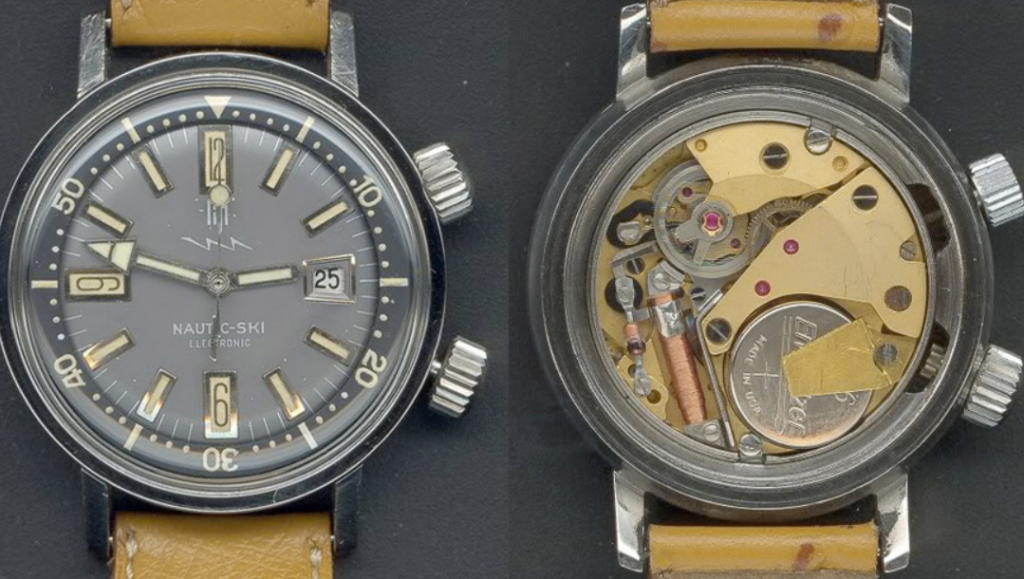
Lip issued the first execution of the Nautic-Ski with a grey dial and black inner bezel. Another variant exists with the blue, white, and red colors of the French flag. (Note: Many vintage examples of the gray-dialed Nautic-Ski have patinaed and stained dials due to the type of finishing or material.)
The ‘Breguet’ Nautic-Skis

Lip issued the 36 mm Nautic-Ski in four other colorways: orange, blue, green, and violet. These variants feature Breguet numerals, and are the rarest and most coveted by Lip collectors (particularly the moss-green-dialed variant).
The Co-Branded Dials

Lip produced the Nautic-Ski for many other watchmakers, including Benrus, Belforte, Elgin, Waltham, Nivada, Revue, Stowa, Universal Geneve, and Vulcain. These watches are virtually identical to Lip-branded models but with co-branded dials and signed movements.
The Nautic 3
Many watchmakers, including Lip, were working on developing prototypes of electric movements in the middle of the last century. Hamilton was the first to market, introducing the Hamilton Electric in 1957. This represented the first major innovation in mechanical watch design in hundreds of years. Prior to 1957, all watches supplied power via a mainspring through either hand-winding or kinetic energy. The Hamilton Electric drew power from an energy cell the size of button.
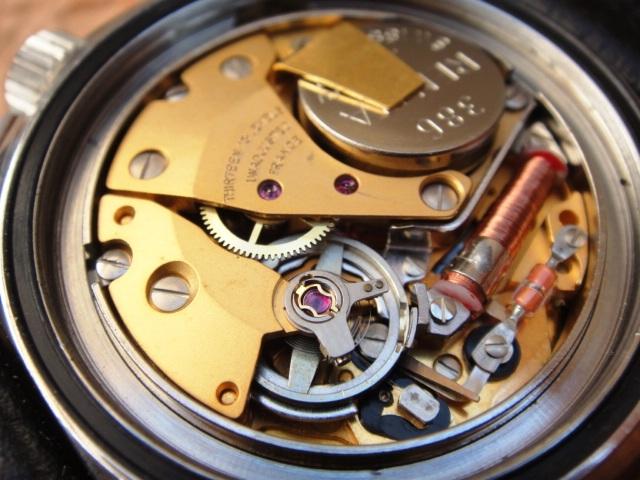
Lip introduced the world’s second electric movement, the Caliber R27, in 1958. (The R27 bears the distinction of being the world’s first “electronic” movement because of the existence of a tiny diode to reduce sparking on the contacts.).

The next generation in Lip’s electric movements arrived in 1962 in the form of the Caliber R148. Compared with the R27 that employed two batteries and two coils, the R148 required only one battery and one coil. This resulted in major improvements in reliability and serviceability and ensured its global success. Lip then introduced a variant with a date and sweep-seconds hand, the R184, which is regarded as the world’s first electric watch movement with date complication.

Servicing R184 can be challenging, but not impossible. There are watchmakers who will work on the R184 and, once serviced, these movements can be as accurate as quartz watches.
What to Look for When Hunting for a Nautic-Ski
Nautic-Skis in all-original, clean condition are getting harder to find. But there are still many collectible examples out there, and for reasonable prices. Expect to pay between $600 and $1,500 for collectible specimens.
Try to buy an example with a working and (if possible) serviced movement. This will save you the trouble of trying to find a watchmaker to repair your R184 (you will need one eventually, but best to try to get some enjoyment out of the Nautic-Ski first). Based on my conversations with Lip experts in Europe, watchmakers have been known to replace the entire R184 movement instead of the servicing the original. Often a 1:1 replacement of the movement is cheaper and easier. Entire R184 movements and parts are difficult, but not impossible, to find. When they do come up for sale, asking prices range between $100 and $300 for a NOS R184 movement. (A fun feature of the R184: If you pull out the crown that sets the time, the movement stops, which saves battery life. Jarett Harkness recommends that if you don’t plan to wear the watch for an extended period of time, to remove the battery to prevent leakage. Energizer batteries are advisable, he says. They rarely leak.)

But be advised: the movements can be difficult to work on.
“The two contact wires are smaller in diameter than a human hair and can be very easily damaged/destroyed if one is not extremely careful,” Harkness says. “The balance assembly is a bit tricky to re-install without disturbing the contact wires. The diode can be tricky to re-install because it is so tiny and light, sits on a tiny platform with nothing to keep it in place during screw installation, and the distance between the coil and balance ‘horn’ has to be just right to get correct amplitude. Too little, and the watch can stop, too much, and the watch can double index causing it to gain time rapidly.”
When it comes to cosmetics, look for evidence moisture intrusion, lume erosion, dial staining, and re-lumed handsets. (Like with all watches, if the lume on the dial and the lume on the handset have a different color, that doesn’t necessarily mean the handset has been replaced or re-lumed). Lip aficionados in France tell me handsets were often replaced by Lip and third-party watchmakers during service. As for cases, for the later models with brushed and polished surfaces, pay close attention to the condition of the mid-case for wear and over-polishing.
When hunting for a MK1 Nautic-Ski or a Super Nautic-Ski, make sure the large cross-hatched crowns are present. New old stock replacement crowns can be difficult to source.
Most examples will come fitted with a rubber strap. Based on my analysis of advertisements from the era, the Nautic-Ski came with a Tropic, Tropic Sport, or Tropic Star. Black, gray, and blue were the most common. Some had a signed buckle.
With persistence and patience, you will be able to find a nice example. Despite the sometimes-troublesome movement, Nautic-Ski’s boldness, build quality, and deliberate eschewing of traditional Swiss styling makes them fun to own. Of all watches from the brand you can hunt for, the Nautic-Ski is the premier exemple of Lip.



